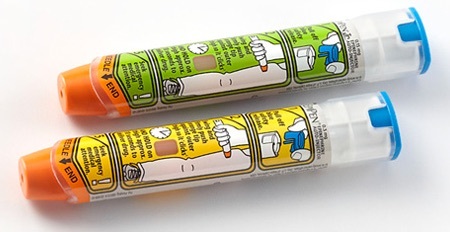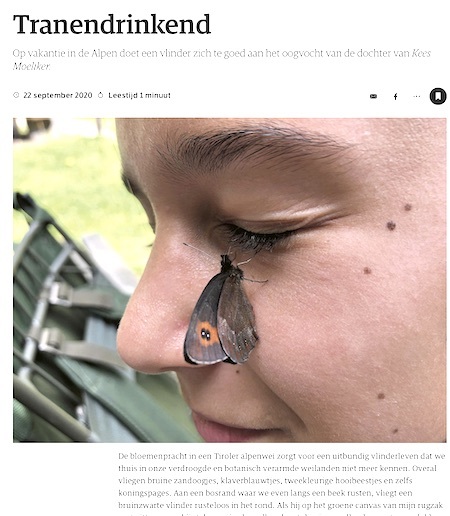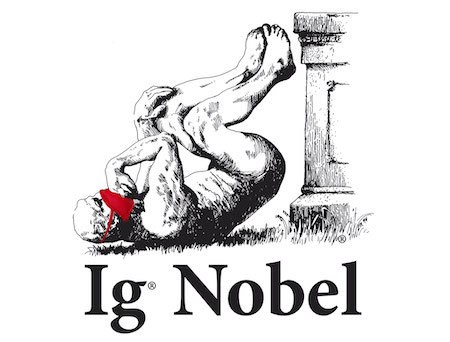Marc Abrahams's Blog, page 100
September 27, 2020
Pocket-Sized #1035: “What Is Stupid”
In this special Pocked-Sized episode #1035, Marc Abrahams shows an unfamiliar research study to Jean Berko Gleason. Dramatic readings and reactions ensue.
The research mentioned in this episode is featured in the special Psychology issue (vol. 26, #1) of the Annals of Improbable Research magazine.

Jean Berko Gleason encounters:
“What Is Stupid?: People’s Conception of Unintelligent Behavior,” Balazs Aczel, Bence Palfi, and Zoltan Kekecs, Intelligence, vol. 53, 2015, pp. 51-58.
Remember, our Patreon donors, on most levels, get access to each podcast episode before it is made public.
Seth Gliksman, Production Assistant
Available on Spotify, Apple Podcasts, Overcast, Google Podcasts, AntennaPod, BeyondPod and elsewhere!

September 25, 2020
Mary Ann Raghanti joins the Luxuriant Flowing Hair Club for Scientists (LFHCfS)
Mary Ann Raghanti has joined the Luxuriant Flowing Hair Club for Scientists (LFHCfS). She says:
(LFHCfS). She says:
The main focus of my research is human brain evolution. I chose this field of study after spending an inordinate amount of time chasing monkeys around forests, hoping against hope that each of them would defecate close to a trail to facilitate fecal sample collection. That was followed by another unusually dedicated time period grinding up said samples for various analyses. Brains, on the whole, smell better. Nevertheless, the beguiling siren call of excreta returns to my lab and research in fascinating forms. I am driven by a passion to understand what makes us human, and one characteristic of our species is the presence bountiful scalp hair. This is just one reason why I am delighted, honored, and humbled to become a member of the LFHCfS.
Mary Ann Raghanti, Ph.D., LFHCfS
Ig Nobel Prize Winner (2020 Materials Science Prize)
Professor and Chair
Department of Anthropology
Kent State University
Kent, Ohio, USA


September 24, 2020
David Hu joins the Hair Club for Scientists (LFHCfS)
David Hu has joined the Luxuriant Flowing Hair Club for Scientists (LFHCfS). He says:
(LFHCfS). He says:
Father-daughter bonding just takes four hair bands. And here is a brief, sad conversation between 9-year-old Heidi and me about that picture:
“Mommy made my hair look like this because I look cute. Do I look cute?”
“No, you look like an old man.”
David Hu, Ph.D., LFHCfS
Ig Nobel Prize Winner (2015 Physics Prize and 2019 Physics Prize)
Professor of Mechanical Engineering and Biology
Georgia Tech
Atlanta, Georgia, USA


September 23, 2020
Meat-Weight Assessment of Washing-Machine-Washed EpiPens
(1) Loading some EpiPens (the little injection devices many people use to treat a bad allergic reaction) into washing machines, and then (2) washing them, and then (3) firing those washing-machine-washed EpiPens into hunks of meat was the basis for an experiment.
Details are in the study: “The Effects of Washing on EpiPen Epinephrine Auto-injector Device Integrity and Function,” Andrew McCray, Julie Brown, and Pingping Qu; Journal of Allergy and Clinical Immunology, vol. 145, no. 2, 2020, p. AB5. (Thanks to Josh Steinberg for bringing this to our attention.)
The authors, at Seattle Children’s Hospital, report:
RATIONALE: Prescribing information for EpiPens indicate that the carrier tube is not waterproof. No studies have shown the effects of submerging an EpiPen in water. We aimed to determine the function and integrity of EpiPens after enduring a washing machine cycle.
METHODS: For 68 pairs of same-dose, same-lot, post-consumer expired EpiPens (15 0.3 mg and 53 0.15 mg), one was washed in its carrier tube through the colors cycle of a top-loading washing machine, while its pair was kept at usual conditions. Both were then fired into meat. The increase in meat mass and decrease in device mass were measured to estimate the mass of solution fired….
RESULTS: Washed devices fired a greater mass of epinephrine solution into the meat and devices lost more mass during firing, versus controls. Ten washed devices failed to deploy the needle cover after firing. The effect of washing did not differ by dose or expiration date….
CONCLUSIONS: Washing EpiPens impaired their function. These devices should not be used if accidentally placed through a washing machine cycle
HAVE PDF

September 22, 2020
Drinking tears (the case of the butterfly and the girl)
Kees Moeliker reports a well-known—but seldom noticed by humans—butterfly behavior: drinking human tears.
Here is a machine-translation into English of his report in the September 22, 2020 issue of the Dutch newspaper NRC:
———
Drinking tears
While on holiday in the Alps, a butterfly feasts on the eye fluid of Kees Moeliker’s daughter
The splendor of flowers in a Tyrolean alpine meadow provides an exuberant butterfly life that we no longer know at home in our parched and botanically impoverished Dutch meadows. Everywhere are mazarine blues, pearly heaths, meadow browns, and even swallowtails.
A brown-black butterfly flies around restlessly at a forest edge where we rest along a brook. When he sits down on the green canvas of my backpack, the orange wing band appears with striking black eye spots with bright white centers. I don’t know the species, but with the iObs app it becomes clear that it is the summer erebia (Erebia aethiops), a common species in the Alps. Nothing new under the sun, but that changes when the butterfly lands on my daughter’s nose. “It is very itchy, Daddy,” says Anna Inez (12), who admirably lets nature take its course, even as the insect slowly moves towards her eye. In cases like this, even on vacation, all I can do is observe and record: the butterfly – a male – is now sitting on her cheek, poking between her narrowed eyelids with its proboscis. My very own child undergoes a blatant attempt of ‘lachryphagy’ – drinking tear fluid – by a European diurnal butterfly!
Thanks to decades of research by Hans Bänzinger, this behavior is known, but only in tropical moths, flies and bees. The Swiss entomologist consistently illustrated the countless articles he published on lachryphagy with terrifying photos of his own wide-open eyes in which insects often greedily feast on his tear fluid.
This tear-drinking has now been recorded in more than a hundred insect species. They are after sodium and proteins, mainly in cattle, horses, deer and elephants and to a lesser extent in caimans, turtles and birds. About 25 insect species, most of them moths, also suck moisture from people’s eyes. In teardrop-drinking butterflies, the proboscis acts as a suction organ that is specially equipped with nasty spines and barbs (for grip) but with a flexible tip, designed not to irritate the victim unnecessarily. Bänzinger only felt extreme pain when attacked by the Lobocraspis griseifusa moth with squinted eyes. With his eyes open, he experienced nothing worth mentioning or ‘pinpricks’. Anna Inez described the feeling as “irritating”.
After barely two minutes the butterfly flies away and lands (because of my glasses?) on my lower lip. I can barely suppress my first reflex (splash!)

September 21, 2020
Pictoline’s pictures of the Ig
Pocket-Sized #1034: “Ice Cream and Human-Powered Flight”
In this special Pocked-Sized episode #1034, Marc Abrahams extracts some flash-frozen bits of history from techno-sociologist Gus Rancatore, proprietor of Toscanini’s Ice Cream.
Today, Gus shares with us the inner workings of human-powered flight and the apocryphal nature of one certain contributor.
Remember, our Patreon donors, on most levels, get access to each podcast episode before it is made public.
Seth Gliksman, Production Assistant
Available on Spotify, Apple Podcasts, Overcast, Google Podcasts, AntennaPod, BeyondPod and elsewhere!

Reinventing the ‘Dandy Horse’ [patent]
A ‘Dandy Horse’ was the colloquial name given to a primitive pedal-less bicycle which was a fashionable mode of transport in Europe around 1819.
Fast forward to 2008, when a US patent was granted for an ‘Apparatus for Shifting Weight from a Runner to a Wheeled Frame ‘

– which, at first glance seems remarkably similar. But, unlike the original, the new invention “transfers part of the weight of the runner/walker to the wheeled frame by an elastic means“. Whereas the Dandy Horse was decidedly non-elastic.
Note: Followers of Nominative Determinism may notice the inventor’s name – Mr. Dandy.
Research research by Martin Gardiner

September 18, 2020
The 2020 Ig Nobel Prize winners
The new Ig Nobel Prize Winners were introduced yesterday, at the 30th First Annual Ig Nobel Prize ceremony.
The ceremony was webcast this year in several versions, including Spanish, Japanese, and British English. The Chinese webcast of the ceremony will happen tomorrow, Saturday, September 19. Here is a recording of the direct-from-Cambridge-Massachusetts version of the webcast:

September 17, 2020
Today—The Ig Nobel Prize Ceremony
The 30th First Annual Ig Nobel Prize ceremony happens today, Thursday, September 17, 2020, at 6 pm US eastern time.
WATCH ONLINE at the ceremony web page
You will also find info there to watch alternative versions in Spanish, Japanese, Chinese, and British English.

Marc Abrahams's Blog
- Marc Abrahams's profile
- 14 followers








